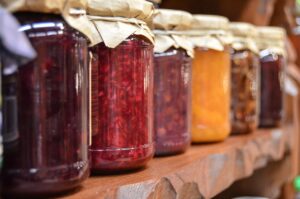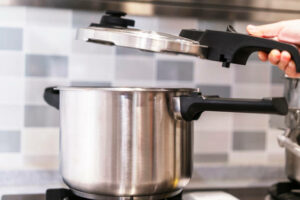Preserving Food
go.ncsu.edu/readext?1020021
en Español / em Português
El inglés es el idioma de control de esta página. En la medida en que haya algún conflicto entre la traducción al inglés y la traducción, el inglés prevalece.
Al hacer clic en el enlace de traducción se activa un servicio de traducción gratuito para convertir la página al español. Al igual que con cualquier traducción por Internet, la conversión no es sensible al contexto y puede que no traduzca el texto en su significado original. NC State Extension no garantiza la exactitud del texto traducido. Por favor, tenga en cuenta que algunas aplicaciones y/o servicios pueden no funcionar como se espera cuando se traducen.
Português
Inglês é o idioma de controle desta página. Na medida que haja algum conflito entre o texto original em Inglês e a tradução, o Inglês prevalece.
Ao clicar no link de tradução, um serviço gratuito de tradução será ativado para converter a página para o Português. Como em qualquer tradução pela internet, a conversão não é sensivel ao contexto e pode não ocorrer a tradução para o significado orginal. O serviço de Extensão da Carolina do Norte (NC State Extension) não garante a exatidão do texto traduzido. Por favor, observe que algumas funções ou serviços podem não funcionar como esperado após a tradução.
English
English is the controlling language of this page. To the extent there is any conflict between the English text and the translation, English controls.
Clicking on the translation link activates a free translation service to convert the page to Spanish. As with any Internet translation, the conversion is not context-sensitive and may not translate the text to its original meaning. NC State Extension does not guarantee the accuracy of the translated text. Please note that some applications and/or services may not function as expected when translated.
Collapse ▲If preserving food is in your plans for this summer, I encourage you to make sure you
have the most up-to-date instructions and safe equipment. We can help.
Food preservation recipes and techniques are constantly being studied and revised. Just because “you’ve always done it this way” or this is how your mother (or grandmother) did it, this may not be the most up-to-date method. Also, just because you found a recipe on the internet or saw it on a cooking show does not make it SAFE.
 Another caution: just because a canning jar SEALS does not mean the food is preserved or SAFE. Sometimes it’s just the opposite. A scary example of this happened a couple of years ago in Ohio. Two deaths were linked to home canned foods. These were potatoes that were processed using the wrong method and then the potatoes were used in a salad and served at a pot luck dinner. One woman died shortly after the dinner from the effects of botulism and many others were hospitalized. Please don’t take risks by not following tested and researched recipes.
Another caution: just because a canning jar SEALS does not mean the food is preserved or SAFE. Sometimes it’s just the opposite. A scary example of this happened a couple of years ago in Ohio. Two deaths were linked to home canned foods. These were potatoes that were processed using the wrong method and then the potatoes were used in a salad and served at a pot luck dinner. One woman died shortly after the dinner from the effects of botulism and many others were hospitalized. Please don’t take risks by not following tested and researched recipes.
When answering questions about food preservation, I seek the assistance of several
valuable resources. One is the National Center for Home Food Preservation at the University of Georgia, they are recognized as a reliable and research-based source of food preservation information. Their website has a wealth of information.
If you like to have a book in hand (instead of a website), “So Easy to Preserve” (6th
edition, 2015) is available from the University of Georgia’s Cooperative Extension. This beautiful book contains the latest recommendations for safe food preservation and lots of recipes. Many consider this to be the best reference available on the topic. You can purchase the book directly from their website at UGA and the National Center for Home Food Preservation. The book is 375 pages and has over 185 tested recipes and in-depth information for both the new and experienced preserver. “So Easy to Preserve” contains information of canning, pickling and sweet spreads, freezing and drying.
Another great reference is the latest (2015) edition of the United States Department of Agriculture’s (USDA) “Complete Guide to Home Canning”. This entire publication can be found online free of charge at the National Center for Home Food Preservation.
Pressure canners are recommended when preserving all low acid foods such as
vegetables, meat or fish.  To ensure that the dial gauges on these pressure canners are accurate, it is recommended that they be tested yearly. We offer this service free of charge. Don’t take the chance of losing all your hard work or preserving unsafe products due to an inaccurate gauge.
To ensure that the dial gauges on these pressure canners are accurate, it is recommended that they be tested yearly. We offer this service free of charge. Don’t take the chance of losing all your hard work or preserving unsafe products due to an inaccurate gauge.
We test canner gauges by appointment. Just call and ask. To have it tested, bring the
canner lid with the gauge attached to the Brunswick County Extension Center in Building N at the Government Center in Bolivia. It only takes a few minutes for the peace of mind knowing your gauge is accurate. Please note: we are only able to test canners made by the Presto company and their associated brands. Weighted gauges do not need to be tested.
If you’re new to canning or would like a “refresher”, our Family and Consumer Science
Agent, Avery Ashley has a basic Canning class scheduled at the Barbee Library on Oak Island on Tuesday August 27 at 10 a.m. This class is free of charge. Check the library’s website for details and to register.
We’re also available to answer your specific food preservation questions. For food
preservation related questions or to schedule a gauge check, contact Avery Ashley at
the Brunswick County Center of N.C. Cooperative Extension Service in Bolivia.
arashley@ncsu.edu or by calling 910-253-2610.
Syracuse is a Family and Consumer Science team member and can be reached at NC
Cooperative Extension, Brunswick County Center 910-253-2610.



